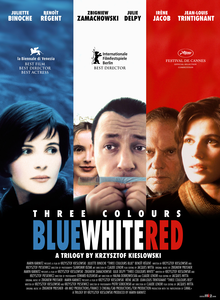Three Colors
| Three Colours trilogy | |
|---|---|
 |
|
| Directed by | Krzysztof Kieślowski |
| Produced by |
Marin Karmitz Yvonne Crenn |
| Written by | Krzysztof Kieślowski Krzysztof Piesiewicz |
| Starring |
Juliette Binoche Zbigniew Zamachowski Julie Delpy Irène Jacob Jean-Louis Trintignant |
| Music by | Zbigniew Preisner |
| Cinematography |
Slawomir Idziak (Blue) Edward Kłosiński (White) Piotr Sobociński (Red) |
| Edited by | Urszula Lesiak |
|
Production
company |
|
| Distributed by | MK2 Distribution |
|
Release date
|
|
|
Running time
|
288 minutes |
| Country | France Poland Switzerland |
| Language |
Blue: French Romanian Polish White: French Polish English Russian Red: French |
| Box office | $6,144,162 (total) |
| Three Colors (soundtracks) | |
|---|---|
| Soundtrack album by Zbigniew Preisner | |
| Released | 1993 - 1994 |
| Genre | Soundtrack, Classical |
| Length |
40:35 35:46 41:57 |
| Label |
Virgin Capitol Records |
The Three Colours trilogy (Polish: Trzy kolory, French: Trois couleurs) is the collective title of three films directed by Krzysztof Kieślowski, two made in French and one primarily in Polish: Three Colours: Blue (1993), Three Colours: White (1994), and Three Colours: Red (1994). All three were co-written by Kieślowski and Krzysztof Piesiewicz (with story consultants Agnieszka Holland and Sławomir Idziak) and have musical scores by Zbigniew Preisner.
Red received nominations for Best Director, Best Original Screenplay and Best Cinematography at the 67th Academy Awards.
Blue, white, and red are the colours of the French flag in left-to-right order, and the story of each film is loosely based on one of the three political ideals in the motto of the French Republic: liberty, equality, fraternity. As with the treatment of the Ten Commandments in Dekalog, the illustration of these principles is often ambiguous and ironic. As Kieślowski noted in an interview with an Oxford University student newspaper, “The words [liberté, egalité, fraternité] are French because the money [to fund the films] is French. If the money had been of a different nationality we would have titled the films differently, or they might have had a different cultural connotation. But the films would probably have been the same.”
...
Wikipedia
